The commercial bill is instrument drawn by a seller of goods on a buyer of goods.
A Commercial bill is one which arises out of a genuine trade transaction, i.e. credit transaction. As soon as goods are sold on credit, seller draws a bill on the buyer for the amount due. The buyer accepts it immediately agreeing to pay amount mentioned therein after a certain specified date.
Thus, bill of exchange contains a written order from the creditor to the debtor, to pay a certain sum, to a certain person, after certain period.
Further, bill of exchange is a ‘self-liquidating’ paper and negotiable; it is drawn always for a short period ranging between 3 month and 6 months.
Bill financing is the core component of meeting working capital needs of corporates in developed countries. Such a mode of financing facilities an efficient payment system.
The commercial bill is instrument drawn by a seller of a goods on a buyer of goods.
Further, RBI has pioneered its efforts in developing bill culture in India, keeping in mind the distinct advantages of commercial bills, like, self-liquidating in nature, recourse to two parties, knowing exact date transactions, transparency of transactions etc.
Example of Commercial Bill
1. If a bank re-discounted a commercial bill with a face with a face value of ₹ 100/- @ 15% for 2 months will fetch ₹ 97.5/- , on the basis of following calculation.
Discount = 100X15/100X2/12 = ₹ 2.50
However, as the discount amount is paid at front- end.
2. The yield to the investor or cost to the borrower will be higher than the discount rate in view of the fact that the discounter can deploy the amount of discount received for earning further income. This can be calculated with the following formula.
D = FV-SV/SV x Days or months in a year/M x 100
Where,
D= Effective Discounting Rate
FV = Face value
SV = Sale value
M = Period of discount



